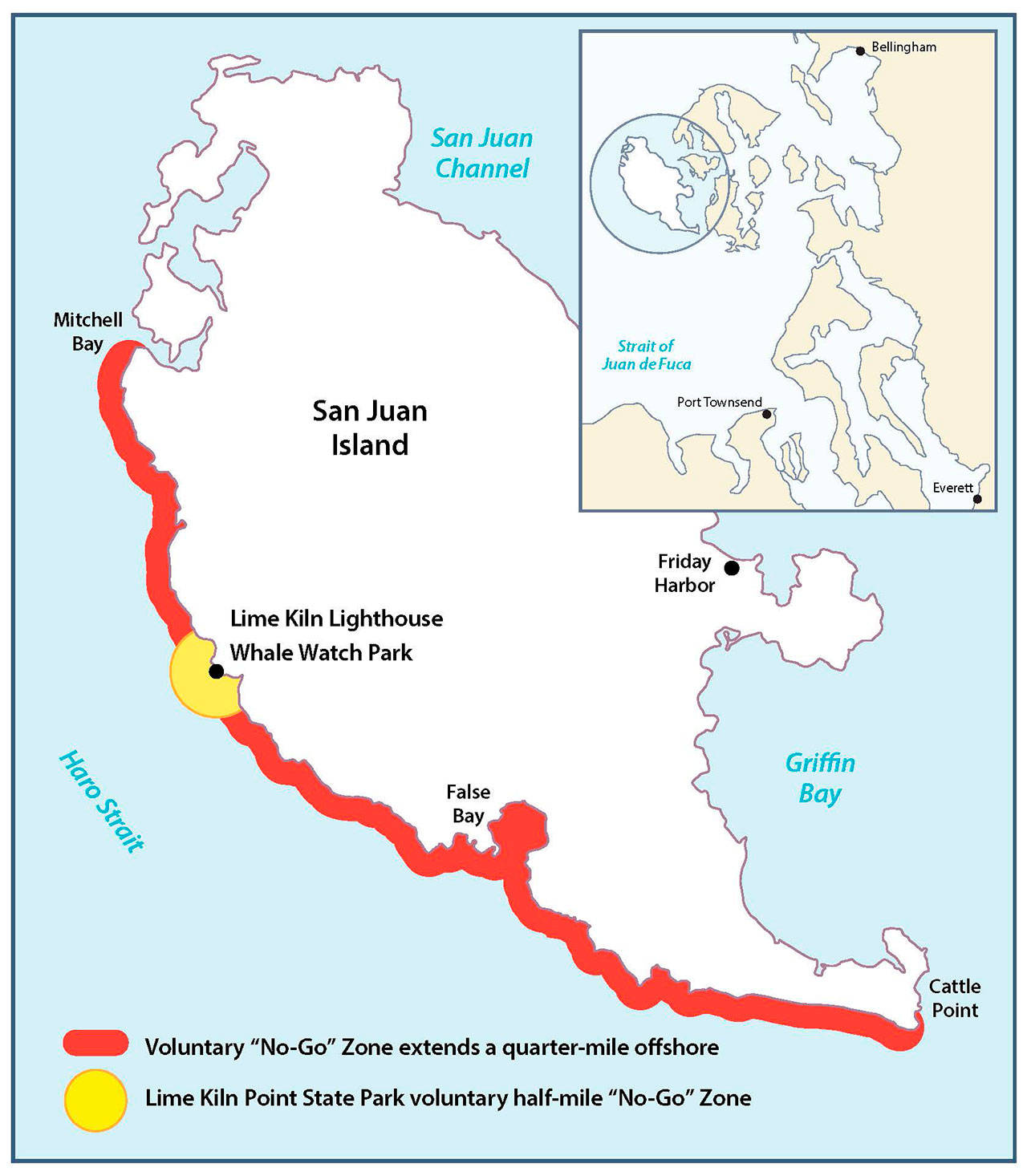Instead of federally banning boats on the west side of San Juan Island to protect orcas, state officials are asking for voluntary restraint.
In early May, Washington Department Fish and Wildlife staff recommended all vessels avoid an area along the west side of San Juan Island to protect the endangered local orcas who are facing a shortage of prey and are known to feed in that location.
A November 2016 petition requested the National Oceanic and Atmospheric Administration Fisheries staff ban motorized boats around the same location for the same reason, as vessel noise and presence have been shown to hinder Southern resident killer whales’ ability to find food.
NOAA staff have yet to review the 2016 petition, according to public relations representative Michael Milstein, as other requests have taken precedence. Now, with the first state-recommended voluntary option, regulations may not be needed.
“Hopefully there will be benefits from the recommended no-go zone, and it may not be necessary to create a formal permanent one,” he said. “It’s always preferable to ask people to do the right thing as opposed to creating regulations.”
The voluntary no-go zone applies to all vessels – from kayaks to power boats, from recreational to commercial – at all times. The area, which the San Juan County Council calls the “Whale and Salmon Sanctuary,” runs from the northern point of Mitchell Bay to the southern tip of Cattle Point on the west side of San Juan Island.
The zone extends a quarter mile offshore, but a half mile around Lime Kiln Lighthouse. Those who launch on the west side are requested to move out of the zone as quickly as possible.
The area is an approximate 5-mile extension of the proposed zone in the 2016 NOAA petition, submitted by Orca Relief Citizens’ Alliance, Center for Biological Diversity and Project Seawolf, which spans from Mitchell Bay to Eagle Point.
The Pacific Whale Watch Association’s nearly decade-old no-go zone for members was in the same location as the petition’s, but was updated last March and now reflects the WDFW-recommended area. The previous no-go zone is also included on laminated local marine stewardship area maps for boaters, which county staff will update to include the extension.
Milstein said NOAA officials recommended fish and wildlife staff to promote the voluntary no-go zone during their annual discussions on how proposed state fishing areas would impact endangered species. In addition to the voluntary vessel-free zone, WDFW staff have reduced salmon fisheries in the San Juan Islands, Strait of Juan de Fuca and Admiralty Inlet.
Southern resident killer whales feed on salmon, mainly Chinook, which is also an endangered species.
Last March, Washington state Gov. Jay Inslee used an executive order to create a task force to protect both Chinook salmon and Southern resident killer whales.
County residents, including San Juan County Councilman Jamie Stephens, Washington state Sen. Kevin Ranker, D-Orcas Island, and Center for Whale Research Founder Ken Balcomb, are part of the 46-member task force.
Stephens explained that ideas generated at a 2017 orca protection workshop in Friday Harbor that are out of the county’s jurisdiction have been passed on to the task force. The group will give final recommendations on how to protect the endangered orcas to the governor by November.
One workshop suggestion that state officials would handle, said Stephens, is to possibly include questions on boating permit tests about federal regulations on vessel proximity to whales.
“The state makes you get a permit to operate a power boat,” he said. “It’s like a driver’s guide; it’s a good idea if ‘Be Whale Wise’ were part of the course.”
“Be Whale Wise” is the marketing campaign to promote the federal regulations adopted by NOAA Fisheries in 2011, including that vessels must stay about two football fields away from Southern resident killer whales, and boaters cannot position vessels in the path of whales within 400 yards.
Local orca protection measures are in the works as well, including encouraging kayakers to launch no more than 10 vessels at a time and wait for orcas to pass before going into the water. County staff are also researching different kayak launching sites on the west side to avoid overcrowding.
They hope to implement whale warning flags, which are also used in Canada, by this July, to raise on both land and in boats when whales are nearby as an extra precaution.
Kendra Smith, San Juan County Environmental resource manager, said county staff, the local whale watchers association, The Whale Museum staff, and the county marine resources committee are also promoting the all-encompassing guidelines for the voluntary zone.
“We’re seeing recreational boaters blast through the west side with not a lot of awareness that there are whales,” said Smith. “So how would you have a zone only when whales are present, or only to September, non-motorized versus motorized? All of those variables muddle the message.”
The voluntary no-go zone was suggested because vessel noise and presence hinders Southern resident killer whales’ ability to search for food, which they do by listening to underwater vibrations reflecting against objects.
The orcas, who call the waters surrounding the San Juan Islands their home for part of the year, face three main threats to extinction, according to the WDFW: a lack of prey, disturbance from vessel traffic and noise and toxins in the water. The governor-appointed task force oversees three subgroups which target each of those specific threats.
Southern resident killer whales have been listed as endangered since 2005. Their population peaked at 98 animals in 1995 but dropped to 76 in December 2017.




